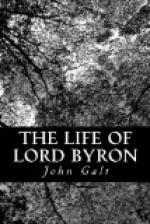CHAPTER III
Arrival at Newstead—Find it in Ruins—The old Lord and his Beetles— The Earl of Carlisle becomes the Guardian of Byron—The Poet’s acute Sense of his own deformed Foot—His Mother consults a Fortune-teller
Mrs Byron, on her arrival at Newstead Abbey with her son, found it almost in a state of ruin. After the equivocal affair of the duel, the old lord lived in absolute seclusion, detested by his tenantry, at war with his neighbours, and deserted by all his family. He not only suffered the abbey to fall into decay, but, as far as lay in his power, alienated the land which should have kept it in repair, and denuded the estate of the timber. Byron has described the conduct of the morose peer in very strong terms:—“After his trial he shut himself up at Newstead, and was in the habit of feeding crickets, which were his only companions. He made them so tame that they used to crawl over him, and, when they were too familiar, he whipped them with a wisp of straw: at his death, it is said, they left the house in a body.”
However this may have been, it is certain that Byron came to an embarrassed inheritance, both as respected his property and the character of his race; and, perhaps, though his genius suffered nothing by the circumstance, it is to be regretted that he was still left under the charge of his mother: a woman without judgment or self-command; alternately spoiling her child by indulgence, irritating him by her self-willed obstinacy, and, what was still worse, amusing him by her violence, and disgusting him by fits of inebriety. Sympathy for her misfortunes would be no sufficient apology for concealing her defects; they undoubtedly had a material influence on her son, and her appearance was often the subject of his childish ridicule. She was a short and corpulent person. She rolled in her gait, and would, in her rage, sometimes endeavour to catch him for the purpose of inflicting punishment, while he would run round the room, mocking her menaces and mimicking her motion.
The greatest weakness in Lord Byron’s character was a morbid sensibility to his lameness. He felt it with as much vexation as if it had been inflicted ignominy. One of the most striking passages in some memoranda which he has left of his early days, is where, in speaking of his own sensitiveness on the subject of his deformed foot, he described the feeling of horror and humiliation that came over him when his mother, in one of her fits of passion, called him a “lame brat.”
The sense which Byron always retained of the innocent fault in his foot was unmanly and excessive; for it was not greatly conspicuous, and he had a mode of walking across a room by which it was scarcely at all perceptible. I was several days on board the same ship with him before I happened to discover the defect; it was indeed so well concealed, that I was in doubt whether his lameness was the effect of a temporary accident, or a malformation, until I asked Mr Hobhouse.




